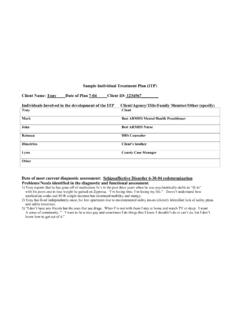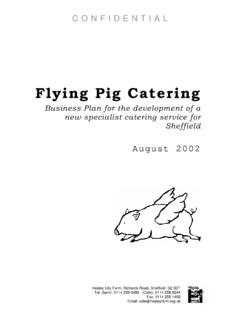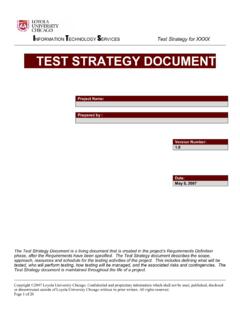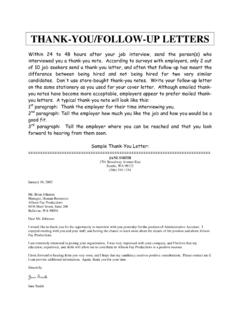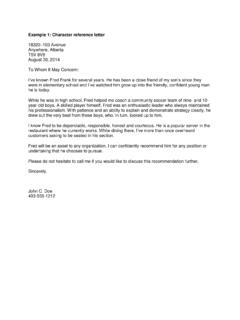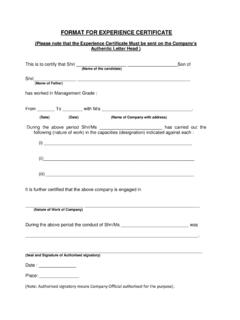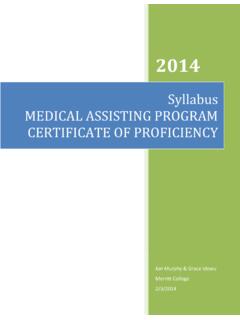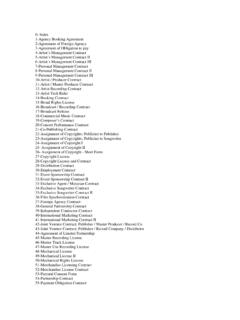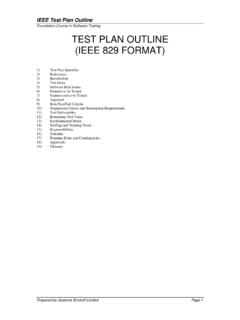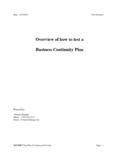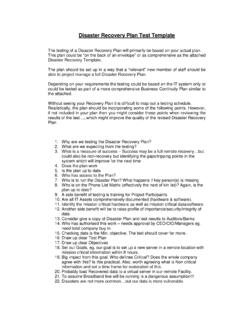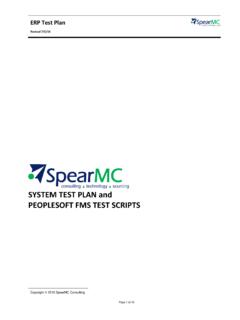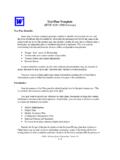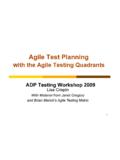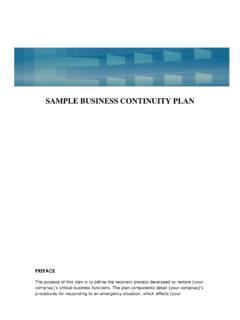Transcription of 8. Master Test Plan (MTP) - Template.net
1 IEEE Std 829-2008 IEEE Standard for Software and System Test Documentation 35 Copyright 2008 IEEE. All rights reserved. 8. Master Test plan (MTP) The purpose of the Master Test plan (MTP) is to provide an overall test planning and test managementdocument for multiple levels of test (either within one project or across multiple projects). In view ofthe software requirements and the project's (umbrella) quality assurance planning, Master test planning as an activity comprises selecting the constituent parts of the project s test effort; setting the objectives for each part; setting the division of labor (time, resources) and the interrelationships between theparts; identifying the risks, assumptions, and standards of workmanship to be considered and accounted for by the parts; defining the test effort's controls; and confirming the applicable objectivesset by quality assurance planning.
2 It identifies the integrity level schema and the integrity levelselected, the number of levels of test, the overall tasks to be performed, and the documentation requirements. Clause 7 specifies how to address the content topics shown in the outline example below. Details onthe content for each topic are contained in through A full example of an MTP outline is shown in the boxed text. Master Test plan Outline (full example) 1. Introduction Document identifier Scope References System overview and key features Test overview Organization Master test schedule Integrity level schema Resources summary Responsibilities Tools, techniques, methods, and metrics 2.
3 Details of the Master Test Test processes including definition of test levels Process: Management Activity: Management of test effort Process: Acquisition : Activity: Acquisition support test Process: Supply Activity: Planning test Process: Development Activity: Concept Activity: Requirements Authorized licensed use limited to: Technische Universitat Kaiserslautern. Downloaded on May 12,2011 at 13:40:36 UTC from IEEE Xplore. Restrictions apply. IEEE Std 829-2008 IEEE Standard for Software and System Test Documentation 36 Copyright 2008 IEEE. All rights reserved. Activity: Design Activity: Implementation Activity: Test Activity: Installation/checkout Process: Operation Activity: Operational test Process: Maintenance Activity: Maintenance test Test documentation requirements Test administration requirements Test reporting requirements 3.
4 General Document change procedures and (MTP Section 1) Introduction Introduce the following subordinate sections. This section identifies the document and places it incontext of the project-specific lifecycle. It is in this section that the entire test effort is described, including the test organization, the test schedule, and the integrity schema. A summary of requiredresources, responsibilities, and tools and techniques may also be included in this section. (MTP Section ) Document identifier Uniquely identify a version of the document by including information such as the date of issue, the issuing organization, the author(s), the approval signatures (possibly electronic), and the status/version( , draft, reviewed, corrected, or final).
5 Identifying information may also include the reviewers andpertinent managers. This information is commonly put on an early page in the document, such as thecover page or the pages immediately following it. Some organizations put this information at the endof the document. This information may also be kept in a place other than in the text of the document ( , in the configuration management system or in the header or footer of the document). (MTP Section ) Scope Describe the purpose, goals, and scope of the system/software test effort. Include a description of any tailoring of this standard that has been implemented. Identify the project(s) for which the plan is being written and the specific processes and products covered by the test effort.
6 Describe the inclusions, exclusions, and assumptions/limitations. It is important to define clearly the limits of the test effort for any test plan . This is most clearly done by specifying what is being included (inclusions) and equallyimportant, what is being excluded (exclusions) from the test effort. For example, only the current newversion of a product might be included and prior versions might be excluded from a specific test effort. In addition, there may be gray areas for the test effort (assumptions and/or limitations) where management discretion or technical assumptions are being used to direct or influence the test effort. For example, system subcomponents purchased from other suppliers might be assumed to have beentested by their originators, and thus, their testing in this effort would be limited to only test the features used as subcomponents in the new system.
7 Authorized licensed use limited to: Technische Universitat Kaiserslautern. Downloaded on May 12,2011 at 13:40:36 UTC from IEEE Xplore. Restrictions apply. IEEE Std 829-2008 IEEE Standard for Software and System Test Documentation 37 Copyright 2008 IEEE. All rights reserved. It is implied that the test tasks will reflect the overall test approach and the development methodology. If the development is based on a waterfall methodology, then each level of the test will be executedonly one time. However, if the development is based on an iterative methodology, then there will bemultiple iterations of each level of test. For example, component testing may be taking place on the most recent iteration at the same time that acceptance testing is taking place on products that weredeveloped during an earlier iteration.
8 The test approach identifies what will be tested and in what order for the entire gamut of testing levels (component, component integration, system, and acceptance). The test approach identifies the rationalefor testing or not testing, and it identifies the rationale for the selected order of testing. The test approach describes the relationship to the development methodology. The test approach may identifythe types of testing done at the different levels. For example, thread testing may be executed at asystem level, whereas requirements testing may take place at the component integration as well as ata systems integration level. The documentation (LTP, LTD, LTC, LTPr, LTR, and LITSR) required is dependent on the selection of the test approach(es).
9 (MTP Section ) References List all of the applicable reference documents. The references are separated into external referencesthat are imposed external to the project and internal references that are imposed from within to theproject. This may also be at the end of the document. (MTP Section ) External references List references to the relevant policies or laws that give rise to the need for this plan , : a) Laws b) Government regulations c) Standards ( , governmental and/or consensus) d) Policies The reference to this standard includes how and if it has been tailored for this project, an overview of the level(s) of documentation expected, and their contents (or a reference to an organizational standardor document that delineates the expected test documentation details).
10 (MTP Section ) Internal references List references to documents such as other plans or task descriptions that supplement this plan , :a) Project authorizationb) Project plan (or project management plan ) c) Quality assurance pland) Configuration management plan (MTP Section ) System overview and key features Describe the mission or business purpose of the system or software product under test (or reference where the information can be found, , in a system definition document, such as a Concept of Operations). Describe the key features of the system or software under test [or reference where theinformation can be found, , in a requirements document or COTS documentation].

